Begonia is a really misunderstood plant, but when you know how to grow begonia properly, and understand their roots, variations, and which subspecies are grown for indoor or outdoor environments, you might think again.
The guide to growing begonias below shares our experience of growing these wonderful plants and teaches everything you need to know about propagating, and common pests (as well as some less common diseases).
More...
What is a Begonia?
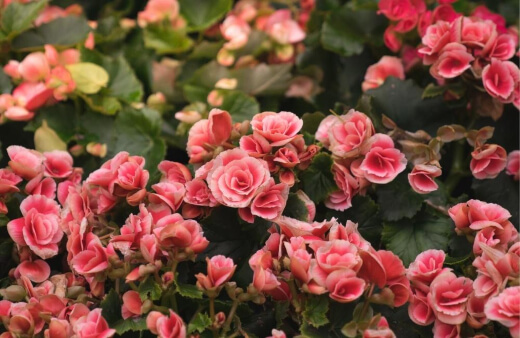
My relationship with begonia started, like most gardeners, with hanging baskets and bedding plants. My grandparents didn’t have a lot of space, but they made every inch of it count with harsh, bold, colours. Waxy leaved begonias were, of course, perfect for that style.
But, in recent years, I’ve come to know these plants better, understanding begonia varieties that will only grow in controlled indoor settings, and polka dot begonias that are nothing like the traditional waxy leaved bedding plants we all know.
Begonia’s Natural Habitat
Begonias are widespread in nature, with species found throughout subtropical and equatorial regions of South America, Africa and Asia. Because they are so widespread they are one of the world’s most adapted and evolved plant species, with notable variation in begonia roots, as well as their leaves.
These adaptations mean that while most prefer moist soils in the cool shade of forest canopies, there are some varieties that prefer the hot dry conditions closer to the equator.
The begonias sold in cultivation are mostly bred to cope with cool, dry conditions, so are perfect for adding excitement to challenging spots in the garden.
Different Types of Begonia (by Roots)
There are four different groups of Begonia, with some important distinctions within those groupings. In the descriptions below I’ll explain some of the key differences between each subspecies, but importantly, a begonia‘s care is most defined by its roots.

The four main groups of begonia are:
- Tuberous Begonias
- Rhizomatous Begonias
- Fibrous Begonias
- Hardy Begonias
Each of the above has very unique growing requirements based on the strength of their roots, but overall, their top growth is fairly similar. One-fifth grouping of begonia, while mostly found in the fibrous-rooted begonia category, is cane begonia.
Cane begonias are distinct from other begonias in their stem structure, which is far more intricate than most begonias, and therefore requires different care, and different propagation.
Tuberous Begonia
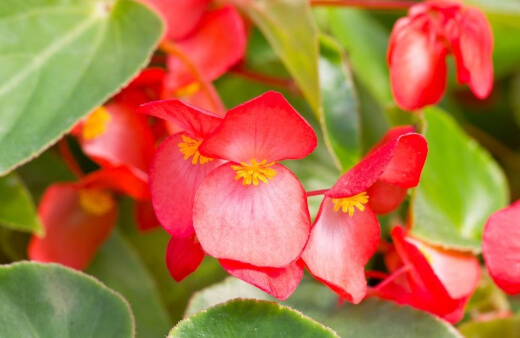
Tuberous begonias grow from tubers, potato-like root structures similar to bulbs in the way they store energy but very different in the way they sprout and grow.
Tubers are far more forgiving than bulbs, and typically hardy, but begonia tubers should always be dug up and stored anywhere where temperatures drop below freezing.
The other incredible thing about begonia tubers is that if you do spike them with a fork when you’re digging them up for winter, they will simply callous over and regrow next year, unlike potatoes (the world’s best-known tuber) which rots after any damage.


Get Your Free Guide:
Master Growing Australian Natives eBook
A Must Have Complete Guide for Every Australian Garden
Get Your Free Guide:
Master Growing Australian Natives eBook
A Must Have Complete Guide for Every Australian Garden
Tuberous begonias tend to have very formal flowers, and deeply veined satin leaves which form mounds and reliably flower again when deadheaded.
Their leaves have much more interest than typical bedding begonias so work well in contemporary gardens where foliage is central to the design.
Rhizomatous Begonia

Rhizomatous begonias are hardier than most begonias. These clever plants push their thick rhizomatous roots to the surface of the soil which means they’re never sat in water for too long.
Their leaves are probably the most varied of all begonia types, with intense variegation, and minute fibrous hairs on their leaves which help protect them from slugs and caterpillars.
If pests are a problem in your garden these are an excellent choice, but they don’t enjoy winters, so like pelargoniums they should be lifted and kept indoors or in the greenhouse over winter.
While rhizomatous begonias aren’t generally sold as house plants, they’re worth trying. So if you’re worried about moving them indoors over winter, why not just grow them indoors in the first place?
Fibrous Begonia
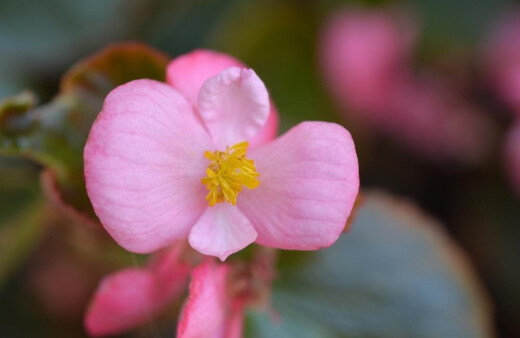
Fibrous begonias, or wax begonias, are generally sold as annual plants but, in fact, make excellent houseplants. They are severely affected by frost, and even cold temperatures below 10°C can kill them, so they should either be treated as houseplants or propagated each year as a bedding display.
Fibrous begonias are the classic bedding plant, with waxy leaves, stringy roots, and while they are easy to divide, they are challenging to keep going.
As long as you take your begonias indoors before the leaves start to droop, you can propagate by division or stem cuttings in spring.
Fibrous begonias will lose most of their leaves in winter, even indoors, so when fresh leaves appear in spring you can divide your plant, or wait until the new stems are 1-2” tall and take cuttings from them (more on that later)
Hardy Begonia

Hardy begonias are just like they sound – hardy. They are much less common than their better-known cousins because they are more natural.
Gardeners are creatures of habit, so when we hear begonia, we head out to the nearest garden centre to buy the blousiest, loudest, brightest plants we can find.
Hardy begonias have a delicate beauty that just isn’t comparable to other species. They are hardy down to around -5°C too, and they’re happy in shady, slightly moist soil.
Hardy begonia roots are fibrous, like wax begonias, drawing nutrients and moisture from as far as possible, but the important distinction is their bulbils, which overwinter, and help hardy begonias to self-seed, and provide a tougher underground energy store for the following year.
Note: Bulbils are small bulb-like structures that form in place of seeds where a flowering plant is pollinated. A common example is leeks, where seed heads develop and form small green bulbils, which dry out with the plant and fall to the ground to overwinter.
Cane Begonia
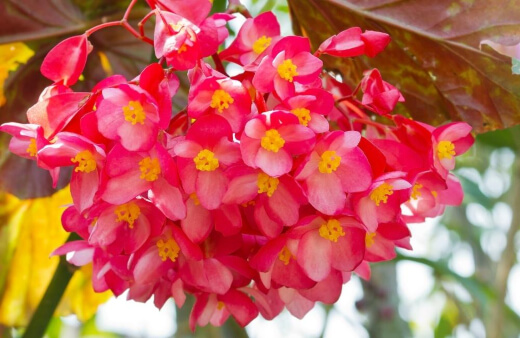
Cane begonias are defined by their top growth rather than their roots, with stems that grow in sections, with new leaves emerging from single stalks. The best-known cane begonia is the Polka Dot Begonia or Begonia maculata so don't miss our growing guide here.
While there is sometimes variation in the root structures of cane begonias, most are fibrous root begonias, so are best propagated by stem cuttings or division in spring.
In most of the world it is best to grow cane begonias, like Begonia maculata, indoors, as they are not at all hardy, and when subjected to wetter weather will quickly wilt.
9 Best Begonia to Grow in Australia
1. Polka Dot Begonia (Begonia maculata)
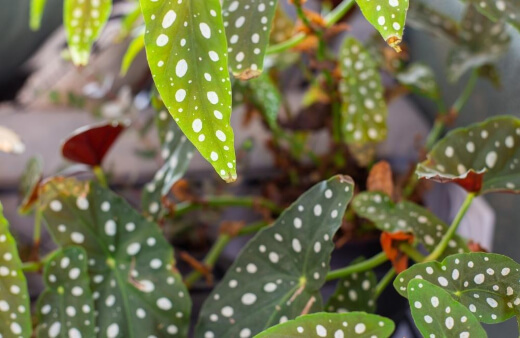
Polka dot Begonia, or B. maculata, are one of the most wonderfully bizarre plants in the natural world. Until recently they were almost impossible to get hold of, but because they have all the wonderful tropical plants like Alocasia Amazonica, without the needy care, they have become incredibly popular.
B. maculata is a cane begonia, so is easy to propagate from division or stem cuttings, and should be kept indoors.
2. Begonia rex

B. rex has the traditional domed form of bedding begonias, with the hardiness of rhizomatous begonias, and the matt leaves of hardy begonias, so they’re a little bit of everything.
They also grow wild in China, North America, Southern Europe and Africa since being introduced by human intervention in the early 1900s, so are incredibly easy to care for.
B. rex grows happily outdoors in Australia, and while it's best to bring them indoors in winter, provided it doesn’t go below -2°C just mulching with a loose compost or bark will protect it from the winter weather.
3. Begonia ‘Escargot’
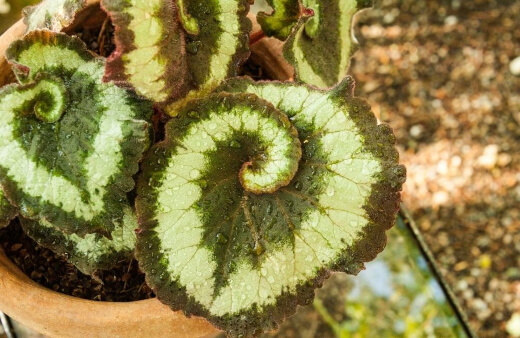
Begonia ‘Escargot’ doesn’t look real, their leaves grow in perfect spirals, with silver variegations, and grow from central roots to form perfect mounds, meaning they look incredible in pots and containers.
Like B. rex, they are deceptively easy to care for, with rhizomatous roots that are happy to overwinter in most Australian gardens. Their leaves and stems will die back in winter, but provided you mulch them they’ll grow back in spring.
(Get to know more about the types of mulch as well as how and when to use them in this guide.)
4. Begonia listada
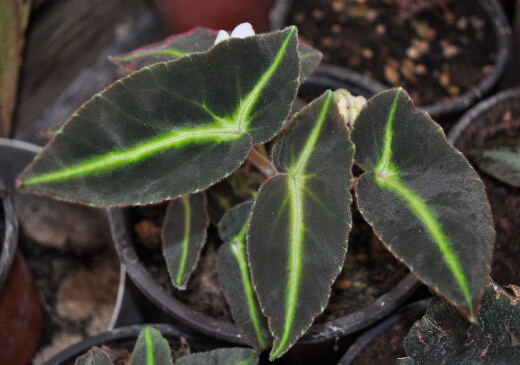
Source: pepiniereezavin.com
B. listada is a rainforest floor plant, with furry leaves and distinct acid green stripes down the centre of an almost black leaf.
Despite very general online articles stating that B. listada is rhizomatous, it is a fibrous begonia, whose roots are only adapted to well-drained soils, so you should keep them indoors, and only water them when they dry out.
5. Begonia ‘Little Brother Montgomery’
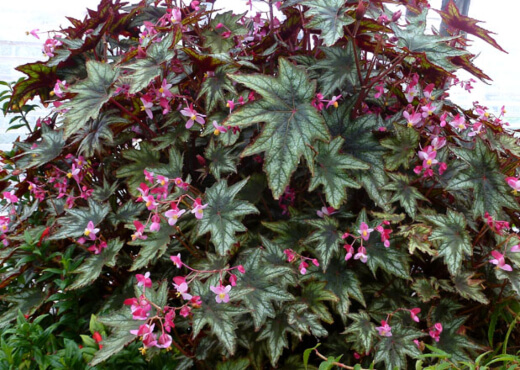
Source: pacifichorticulture.org
Begonia ‘Little Brother Montgomery’ is still a pretty rare plant, as one of the more recently discovered cane begonias. Their palmate leaves stem out from tall canes which make it one of the bushiest, and tallest, begonias you can buy.
As a cane begonia, it should be kept indoors, or in spaces where temperatures never drop below 5°C. They are quite challenging to get flowers from, but their leaves are their best feature.
6. Begonia ‘Candy Stripe’
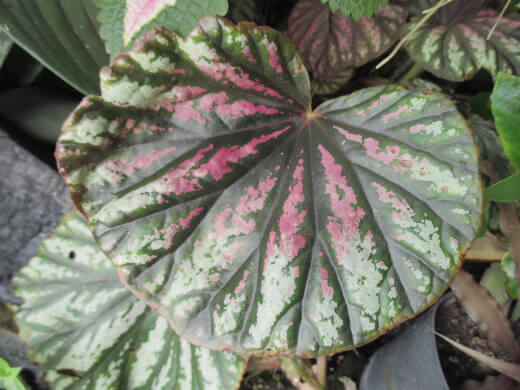
Source: jamesmissier.blogspot.com
This rhizomatous begonia is almost metallic, with its blood-red leaves that stay in place until the first frost, and can be left outdoors in Australia provided it is generously mulched.
It’s not as hardy as other rhizome rooted begonias, but can last through most winters and return in spring. If you’re trying to get flowers from this striking begonia, it needs indirect sun, so should be planted somewhere bright but with shade from midday rays.
7. Wax Begonias

I’m cheating here, as there are hundreds of varieties of wax begonias, but I can’t fit them all in here! Wax begonias are the classic bedding plant that every garden was filled to the brim with until the 1980s, but they’re back now, and planted with consideration in terracotta pots, or simple white containers they convey a gentle Mediterranean style.
They can cope with full sun, provided they are well watered too, so are slightly more adaptable than other begonias.
8. Begonia boliviensis
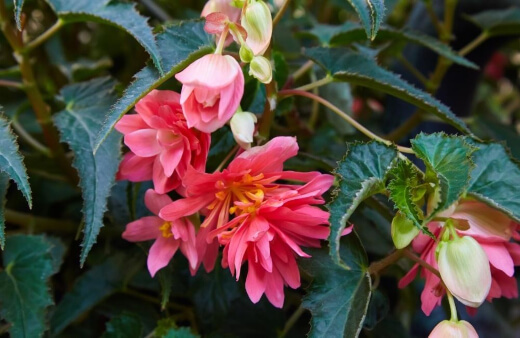
As the name suggests, B. boliviensis is from Bolivia, and like every plant from Bolivia, it’s flamboyant. Its flowers are elongated and very different from any of its cousins, specially adapted for the Bolivian pollinators.
Their leaves are finer, with more exaggerated serrations, like wispy acers and extreme palmate form. B. boliviensis is perfect for hanging baskets too as they naturally flower on drooping stems.
9. Rieger Begonias

Rieger Begonias, or Begonia x hiemalis, were developed for better hardiness outdoors for European growers, but the accidental effect was that they were almost indestructible here.
Rieger Begonias enjoy dappled sun, rather than shade, and need regular watering, but as a cross between fibrous wax begonias and tuberous begonias, they are much easier to propagate, far more likely to return for a second year, and come in a huge variety of colours.
How to Grow Begonias in Australia
As you might expect, growing begonia is relatively straightforward, as it's one of the most common garden plants on the planet, but there are some important variations in how to grow tuberous begonias from how to grow fibrous begonias. Rather than a blanket explanation that covers most bases then, I’ve broken down begonia care into four distinct groups; tuberous, fibrous, rhizomatous, and hardy.
Each section below details how to care for, and how to propagate each type (with an extra section on propagating cane begonias too).
The care guide below details the light conditions, growing medium and ideal fertilisers for different types of begonias too.
Growing Tuberous Begonia

Caring for Tuberous Begonia
Tuberous begonias are the widest spread Begonia species in the world, with varieties found in South America and southern Africa, so are used to moist but well-drained soils and dappled shade.
They should be planted out of direct midday sun and kept well-watered in dry periods, but other than that is fairly easy to care for. If you have poor or sandy soil, it’s a good idea to fertilise them with a general-purpose garden feed once every two weeks to boost their flowering.
Storing Begonia Tubers
Tuberous begonias should be stored for winter if your garden drops below freezing. We live in a cool part of the country and experimented one year where the frosts were around -2°C. The tubers didn’t return at all.
To store begonia tubers for winter:
- Dig begonia tubers up just before the first frost
- Cut off all top growth leaving 3-5” of the stem to dry out above to tuber (this prevents rot)
- Leave them in a cool dry place, out of direct sunlight, for around a week
- Pull off the dry stems, and shake off any soil (do not wash them)
- Place them in a breathable bag filled with moss, vermiculite or even shredded paper to control the moisture.
- Leave the bag of tubers in a cool (around 5°C) place until spring.
Tip: If you want to save time preparing tubers for storage, stop watering as soon as begonias stop flowering in late summer. They don’t need the water, and it will help to prepare the tubers for winter.
Propagating Tuberous Begonia from seed
To grow tuberous begonias from seed you should start them in winter. If you start tuberous begonias from seed in spring they will grow leaf but not flower the same year, and as they are not fully hardy, you’re highly unlikely to have a plant strong enough to survive winter without sowing early.
Sow tuberous begonias in mid-late winter indoors on fine (or sieved) compost. Cover the seeds lightly in sieved compost (5mm) and water them once, then cover with plastic or glass to keep the moisture in.
Make sure the temperature is above 18°C, and you should see germination within 10-24 days depending on light levels.
How to Propagate Tuberous Begonia from cuttings
It isn’t possible to take root cuttings from tuberous begonia, unlike other tubers, which grow from multiple points as the tubers are prone to disease over winter and in early spring.
The best way to take cuttings from tuberous begonias is to cut their stems at the base (as close to the tuber as possible, without cutting the tuber). Insert the cut stems into damp cutting compost or vermiculite and cover tightly with a clear plastic bag or small cloche.
After about a month, the cuttings should be well rooted provided the soil doesn't dry out completely. Gradually remove the plastic bag over the course of a week to acclimatise the young plants to normal humidity.
Tuberous begonias grown from cuttings can be planted in the garden as soon as roots appear at the base of the pots, and should form their own tubers by early autumn.
How to Grow Rhizomatous Begonia

Caring for Rhizomatous Begonia
Rhizomatous begonias prefer indirect light or dappled shade but do enjoy some morning or late afternoon sun. While they don’t like sitting in water, they also really don’t like baking, so organic mulches or compost, leaf litter, or bark chippings help prevent their surface rhizomes from baking in direct sun.
If you have very fast-draining sandy soil, improve the planting hole by digging compost through, and even adding manure to the base of the planting hole while begonias are established to improve water and nutrient retention.
While newly planted rhizomatous begonias need regular water, once they are established they will live with short periods of drought.
Rhizomatous Begonia Winter Care
Rhizomatous begonia is generally hardy in Australia and can survive frosts down to -5°C so in most gardens just need a little bit of a winter mulch to protect their half-buried rhizomes from cold weather.
Winter will kill off all top growth in rhizomatous begonia, but new growth will quickly appear in spring.
How to Propagate Rhizomatous Begonia
Rhizomatous begonias do not propagate well from seed or cuttings, but it can be done. Germinating rhizomatous begonia is the same process as germinating tuberous begonias, but it will take up to 2 months to see results, and they can be erratic.
The best way to propagate rhizomatous begonia is with their rhizomes. Simply cut off a 2” section of rhizome, and lay it on the ground. Cover it with mulch and keep it well watered in spring and summer.
You can take begonia rhizome cuttings like this at any time of the year by propagating them indoors, but in spring this can be done by laying the root cuttings directly on loose soil where they are to grow.
Growing Fibrous Begonia

Caring for Fibrous Begonia
Fibrous begonias are much easier to grow, and their seeds are more common in garden centres and DIY stores thanks to their popularity as bedding plants.
These classic wax begonias are almost all native to South American rainforests though, so are not at all hardy. If you’re growing wax begonias as bedding plants, the likelihood is that you’re not planning to overwinter them, and will buy them next year.
If that’s the case, then feed them as much as possible. Water them with hanging basket fertiliser, or add Miracle-Gro Pellets to their soil near the root ball. The more you feed wax begonias, the more they flower.
How to Propagate Fibrous Begonia
Wax begonias are relatively easy to propagate, but they take ages. Start them as early as possible in spring in a warm windowsill, as they can take 1-2 months to germinate.
Most gardeners will tell you that begonias are cheap to buy as seedlings instead of seeds, which is true, but if you get it right, you can get 100 plants for the price of 10 by sowing early.
Sow wax begonia seeds on the first day of spring, on a warm windowsill, indoors. Water them well, cover them with 5mm of compost, and cover them with a clear sheet of plastic or glass.
(Make your own compost using the best compost bins available in Australia.)
By late spring you should have dozens of young plants ready to prick out into bigger pots, and they will root quickly. As soon as they have roots peeking out of the base of their pots, plant them in the garden.
Propagating Cane Begonia
Other than propagation, caring for cane begonia is the same as any other fibrous begonia. They will grow outdoors in summer but need bringing in for winter and are generally less adaptable than other begonias.
Personally, I prefer to keep any begonias as houseplants so they’re protected from weather changes throughout the year.
Propagating cane begonia is, in theory, the same as propagating wax begonias, but where wax begonia will root quickly into loose compost, cane begonia should be rooted from stem cuttings in vermiculite. The drainage is crucial for these plants at their early stage.
How to Grow Hardy Begonia
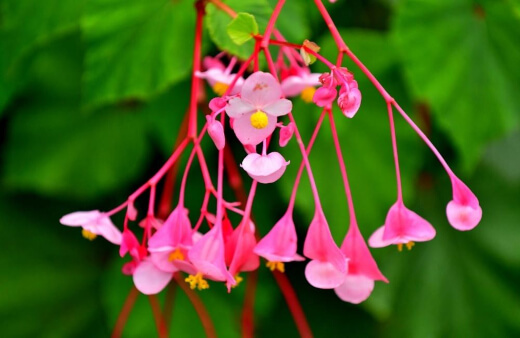
Caring for Hardy Begonia
The ideal conditions for hardy begonia are shade, with morning, or late afternoon sun, and rich, fertile soil that doesn’t get waterlogged. In these conditions, hardy begonia will readily self-seed and expand its clump each year.
When the top growth dies back in winter, protect the roots with a layer of bark, compost or leaf mulch.
Propagating Hardy Begonia
Once you have one hardy begonia, you have the materials for an endless supply of begonia, with easy self-seeding, and fast-spreading plants that are relatively easy to control.
Their bulbils, the tiny bulbs that grow at the base of flowers, can be harvested and sown as soon as they dry out. They will almost all germinate at a temperature above 15°C, so a windowsill or table indoors is ideal.
Alternatively, divide the plant by digging up clumps of root and top growth; cut back the top growth to 5” above the soil, and replant it in any shady spot in the garden. It should quickly start to regrow.
Begonia Pests and Diseases

Begonia Pests
Vine Weevil
Vine weevil grubs are particularly frustrating on tuberous begonias. The grubs burrow into the tubers causing irreparable damage, and the only effective treatment is the preventative use of nematodes, a parasitic insect that feeds on vine weevil grubs.
The effects of vine weevil rubs on begonias are a generalised weakening of plants, with dropping leaves, dropping petals, and black stems caused by root rot.
Earwigs and Caterpillars
Organic treatments can be very effective against earwigs and caterpillars on begonias. Thankfully, it’s rare for these pests to cause any lasting damage to your begonias, so the best method of control is adding a bird feeder to the garden as birds will quickly eat any active caterpillars and earwigs.
Alternatively, spray a saltwater spray over the plants, leave it to dry, then rinse the plant.
Mites
Tarsonemid Mites are minute creatures that are barely visible to the naked eye. Their secretions cause corky deposits on begonia stems and lead to rotting leaves and growing tips.
Blacken tips on begonia are a sign of fungal or bacterial rot and are often caused by these mites. Tarsdonamis mites are very hard to spot, and very efficient moving between plants, so have become known as the begonia plague.
The only effective treatment is the introduction of organic predators, Amblyseius cucumeris, or Neoseiuluis cucumeris.
Eelworm
Eelworms are easy to treat but frustratingly contagious. They attack leaves and roots. Plants that have been attacked at their roots can’t be saved and should be burned so as not to spread the problem.
Begonia with eelworm on the leaves can be submerged in hot water with dish soap. This treatment sterilises the plant and kills the pests.
Roots of tuberous begonia will have visibly swollen, twisted tubers when they are infected, and the top growth will brown off.
Leaf infestations cause browning of the leaf from the central veins to the outside edge of the leaf.

Begonia Diseases
Mildew
Mildew on begonias is simple to treat with a baking powder spray, once every two days in the morning. The afternoon sun will dry the spray off, and the baking soda residue will treat the fungus.
Tuber Rot
Begonias don’t like sitting in water. Root rot is a common problem, and in general, it’s best to cut your losses and dispose of the rotting plants, but it is possible to save begonia tubers, by simply cutting off any dark cabs after washing your tuber in warm water.
Peel the scab off with a sharp knife, or potato peeler, and leave the tuber to callous over for a day or 2. Then plant it back out in dry weather.
Stem Rot
Begonias prefer dry soils, and the less humidity in the air, the better. Overcrowded begonia can suffer from stem rot as moisture sticks to damaged parts of the stem.
If your stem rot is completely brown, even powdery (like tomato blight) the only option is to cut the entire plant back to the ground, carefully placing the stem in a bin bag without allowing any spores to blow onto nearby begonia plants.
Dig out the tuber, wash it, and dry it out for a few days. It will grow again next year, provided the rot hasn’t gone all the way to the base.
Sun Scorch
Begonia likes free-draining soil, and warmth, but that’s often misunderstood as full-sun. Begonia needs shade from the direct midday sun, so should be grown in some shade, either under a tree or if grown indoors, under a greenhouse or conservatory screen.
Signs of sun scorch are white leaf tips on otherwise healthy plants. Begonias with sun scorch will recover, just cut off the affected leaves as new growth starts to show.
Damp blooms
While we advise misting their growing space for indoor begonias in the early growing season, they should not be misted when flower buds begin forming.
Over-humidifying flower buds leads to heavy, wet flowers that won’t open properly. You’ll notice brown sticky edges to each petal that create a damp crust, which stops the flower opening.
To fix this, reduce the humidity, and then deadhead any damp flowers. Begonias will repeat flower after vigorous deadheading.
Foliar Petal
Almost like reversion in variegated plants, begonias can get a little confused. When a begonia petal turns green and begins forming as a leaf where a flower should be, this is called a foliar petal. Essentially a leaf in place of petals.
This isn’t anything you’ve done, just a problem with overbreeding of plants. Plants are bred to look a certain way, and occasionally they just decide to fight back.
If you’re worried about the look of the foliar petals, just cut them back and your begonia should start to behave itself again.
Begonia Frequently Asked Questions
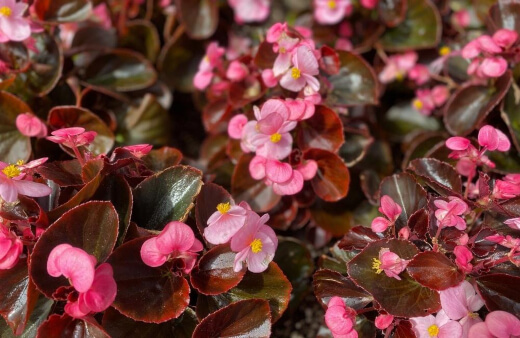
Do begonias like sun or shade?
While all begonias will tolerate full sun, they won’t grow as vigorously and can suffer from sun scorch (particularly tuberous and rhizomatous begonias). Begonias prefer partial shade, or dappled shade, with rich well-drained soil.
Do begonias come back every year?
Most begonias are grown as annual plants but they are perennials, which can be dug up and brought indoors, or have their tubers dried and stored for re-planting. Even fibrous begonias are perennial as long as they’re grown indoors.
How often should begonias be waters?
Begonias need moisture but don’t like sitting in water, so in normal weather, water them once a week (more in the first month after planting), and don’t water them when the ground is still wet.
In serious drought, you can help begonias and save water by mulching with bark, compost, or leaf litter to help them retain moisture.
When do begonias flower?
Begonias flower all summer with regular deadheading, and if properly watered and fed, they will flower for up to 2 months before they begin to fade.
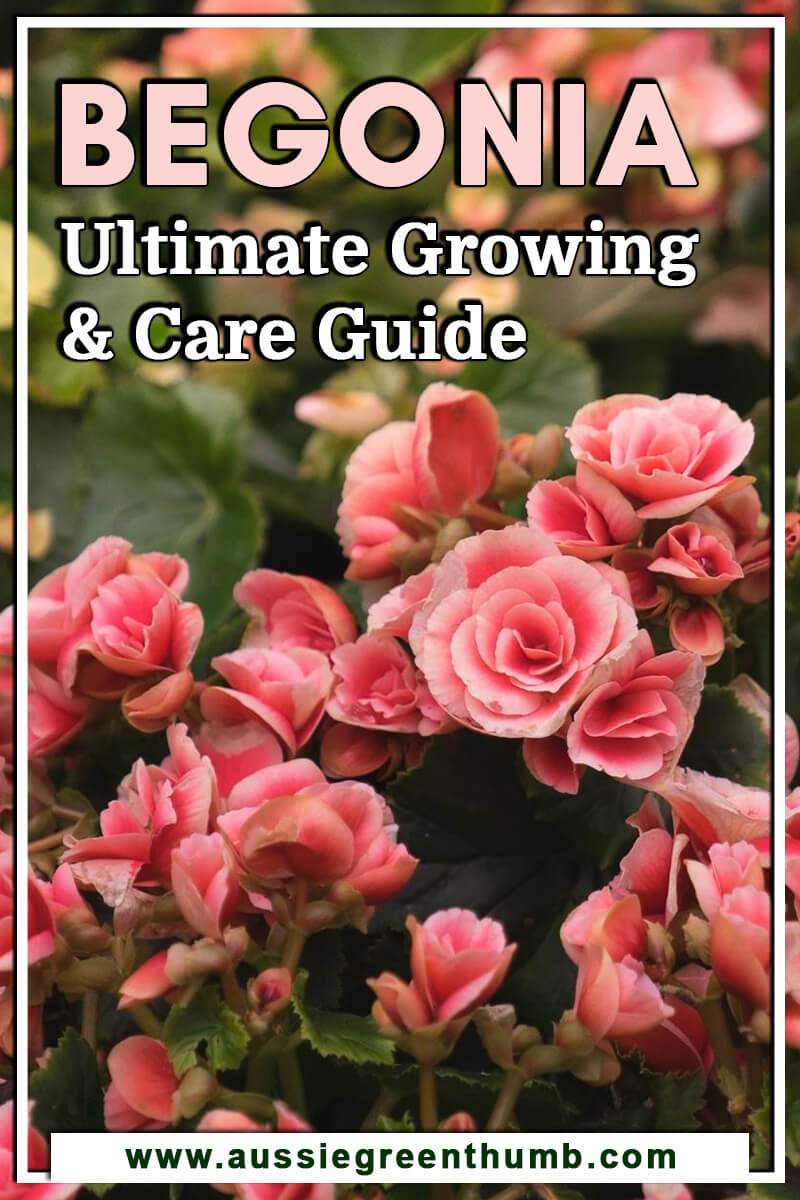
Enhance your Outdoor Space Effortlessly with Begonias
If you were in the camp that thought begonias were unfashionable plants that your grandparents used to grow, I hope I’ve changed your mind. Begonias are incredibly clever plants and a perfect example of evolution in action
A single species of plant travelling the globe and adapting not just its leaves, but its stems, its roots, its flowers and its seed structures just so it can survive in every condition.
So, whether you’re in love with them or not, at least you know how to grow begonias, so you’ve got no excuse.
Published on March 4, 2022 by Maisie Blevins
Last Updated on February 10, 2024





Are you able to send me a copy of your Begonia Ultimate Growing and Care Guide.
If it is not possible to post a copy an electronic copy by email will be appreciated.
Thank you.
One of the activities my wife and I experienced while in Canada was a visit to the Butchart Gardens near Victoria on Vancouver Island, British Columbia.
There they had an exquisite display of innumerable varieties of Begonias most of which we had never seen anywhere in Australia. As a result I sent an email requesting information about the varieties they were growing and the following is extracted from their reply; We have quite the diverse collection here.
We grow many different varieties – far too many to list but for example each ‘type ‘ below has several different varieties and we grow so many!
Non Stop Tuberous Begonia
Fibrous Begonia
Garden Standard Tuberous Begonia
Angelwing Begonia
Rex Begonia
Rieger Begonia
Pin Up Begonia
Jurassic Series Begonia
Do you have knowledge of these varieties and are they available in Australia and from you?
Hey Brian,
Thanks for reaching out. We are currently working on having downloadable growing guides, I can email it to you once the Begonia one is completed.
Best regards,
Maisie Blevins
Hi Brian,
We don’t sell plants, but there are some wonderful Begonia specialists who do. If you’re ever really wanting to find out more about Begonias, and talk to like minded obsessives, it’s worth joining your local Begonia society. They have really passionate members who love sharing information about more unusual types.
Some of the ones you’ve mentioned though, like Rex Begonias and fibrous Begonias in particular cover a whole host of possible cultivars, with massively varied foliage and colours. Rex are pretty easy to grow in Australia though as long as they don’t stay too wet over winter.
My personal favourite is Begonia ‘Escargot’. It’s just really unique, and grows well outdoors if you try to keep it reasonably humid even growing it in a container by a pond would do.
Best regards,
Maisie Blevins
Please tell me how I can obtain a copy of Begonia Ultimate Growing and Care Guide
Hey Brian,
We are currently working on a way that our growing guides can be downloaded, I have your email and will contact you once this function is working.
Best regards,
Maisie Blevins